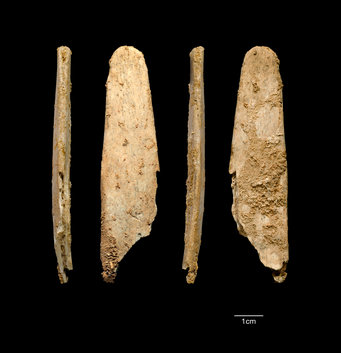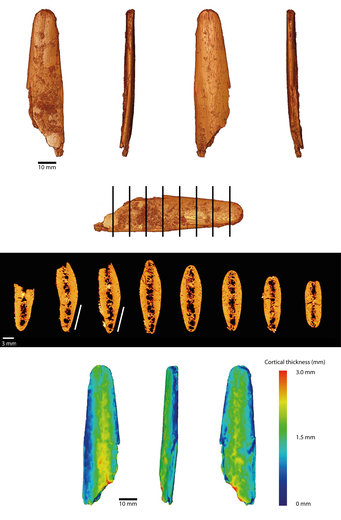Neandertals made the first specialized bone tools in Europe
New finds demonstrate: Neandertals were the first in Europe to make standardized and specialized bone tools – which are still in use today
Two research teams from the Max Planck Institute for Evolutionary Anthropology in Leipzig, Germany, and the University of Leiden in the Netherlands have jointly reported the discovery of Neandertal bone tools coming from their excavations at two neighboring Paleolithic sites in southwest France. The tools are unlike any others previously found in Neandertal sites, but they are similar to a tool type well known from later modern human sites and still in use today by high-end leather workers. This tool, called a lissoir or smoother, is shaped from deer ribs and has a polished tip that, when pushed against a hide, creates softer, burnished and more water resistant leather. The bone tool is still used today by leather workers some 50 thousand years after the Neandertals and the first anatomically modern humans in Europe.
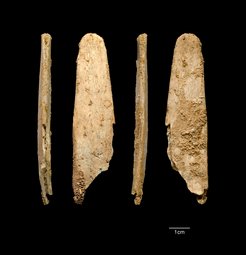
Modern humans replaced Neandertals in Europe about 40 thousand years ago, but the Neandertals’ capabilities are still greatly debated. Some argue that before they were replaced, Neandertals had cultural capabilities similar to modern humans, while others argue that these similarities only appear once modern humans came into contact with Neandertals.
“For now the bone tools from these two sites are one of the better pieces of evidence we have for Neandertals developing on their own a technology previously associated only with modern humans”, explains Shannon McPherron of the Max Planck Institute for Evolutionary Anthropology in Leipzig, Germany. He and Michel Lenoir of the University of Bordeaux have been excavating the site of Abri Peyrony where three of the bones were found.
"If Neandertals developed this type of bone tool on their own, it is possible that modern humans then acquired this technology from Neandertals. Modern humans seem to have entered Europe with pointed bone tools only, and soon after started to make lissoirs. This is the first possible evidence for transmission from Neandertals to our direct ancestors,” says Marie Soressi of Leiden University in The Netherlands. With William Rendu of the CNRS, Soressi and her team found the first of four bone tools during their excavation at the classic Neandertal site of Pech-de-l’Azé I.
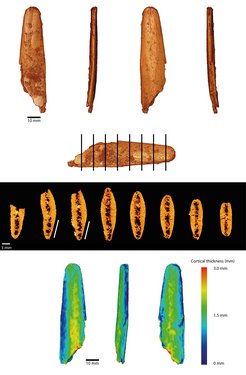
However, we cannot eliminate the possibility that these tools instead indicate that modern humans entered Europe and started impacting Neandertal behavior earlier than we can currently demonstrate. Resolving this problem will require sites in central Europe with better bone preservation.
How widespread this new Neandertal behavior was is a question that remains. The first three found were fragments less than a few centimeters long and might not have been recognized without experience working with later period bone tools. It is not something normally looked for in this time period. “However, when you put these small fragments together and compare them with finds from later sites, the pattern in them is clear”, comments McPherron. “Then last summer we found a larger, more complete tool that is unmistakably a lissoir like those we find in later, modern human sites or even in leather workshops today.”
Microwear analysis conducted by Yolaine Maigrot of the CNRS on of one of the bone tools shows traces compatible with use on soft material like hide. Modern leather workers still use similar tools today. “Lissoirs like these are a great tool for working leather, so much so that 50 thousand years after Neandertals made these, I was able to purchase a new one on the Internet from a site selling tools for traditional crafts,” says Soressi. “It shows that this tool was so efficient that it had been maintained through time with almost no change. It might be one or perhaps even the only heritage from Neandertal times that our society is still using today.”
These are not the first Neandertal bone tools, but up to now their bone tools looked like stone tools and were made with stone knapping percussive techniques. “Neandertals sometimes made scrapers, notched tools and even handaxes from bone. They also used bone as hammers to resharpen their stone tools,” says McPherron. “But here we have an example of Neandertals taking advantage of the pliability and flexibility of bone to shape it in new ways to do things stone could not do.”
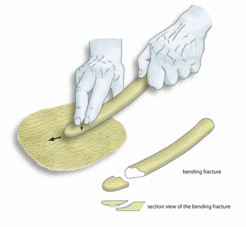
The bone tools were found in deposits containing typical Neandertal stone tools and the bones of hunted animals including horses, reindeer, red deer and bison. At both Abri Peyrony and Pech-de-l’Azé I, there is no evidence of later occupations by modern humans that could have contaminated the underlying levels. Both sites have only evidence of Neandertals.
To know the age of the bone tools, Sahra Talamo of the Max Planck Institute for Evolutionary Anthropology applied radiocarbon dating to bones found near the bone tools themselves. At Pech-de-l’Azé I, Zenobia Jacobs of the University of Wollongong applied optically stimulated luminescence (OSL) dating to sediments from the layer with the bone tool. The results place the Pech-de-l’Azé I bone tool to approximately 50 thousand years ago. This is well before the best evidence of modern humans in Western Europe, and it is much older than any other examples of sophisticated bone tool technologies.
###
Shannon P. McPherron is the senior archaeologist in the Department of Human Evolution at the Max Planck Institute for Evolutionary Anthropology in Leipzig, Germany. He excavates in Ethiopia, Morocco and southwest France, and started the Abri Peyrony project along with Dr. Michel Lenoir of the CNRS in 2009. The goal of his work in southwest France is to better understand Neandertal adaptations just prior to the arrival of modern humans. In Africa his research is focused on the archaeology of anatomically modern humans contemporary with European Neandertals and on the earliest evidence for stone tool use.
Marie Soressi is assistant professor at Leiden University in the Netherlands. Through on-going or recent multidisciplinary and international excavations that she is leading, she focuses on better understanding the demise of Neandertals and the expansion of anatomically modern human populations. She excavates in France, and has also worked in South-Africa. She is a research associate to the Department of Human Evolution at the Max Planck Institute for Evolutionary Anthropology in Leipzig, Germany, and recently acted as project leader for the French National Institute for Preventive Archaeology (INRAP).
###
Excavation permits and funding were provided by the Musée National de Préhistoire des Eyzies, the Service Régional de l’Archéologie d’Aquitaine, the Service Départemental de l’Archéologie de la Dordogne, the Commission inter-régionale de la Recherche Archéologique d’Aquitaine, the Conseil Général de Dordogne, the Australian Research Council (DP1092438) and the Max Planck Society.
